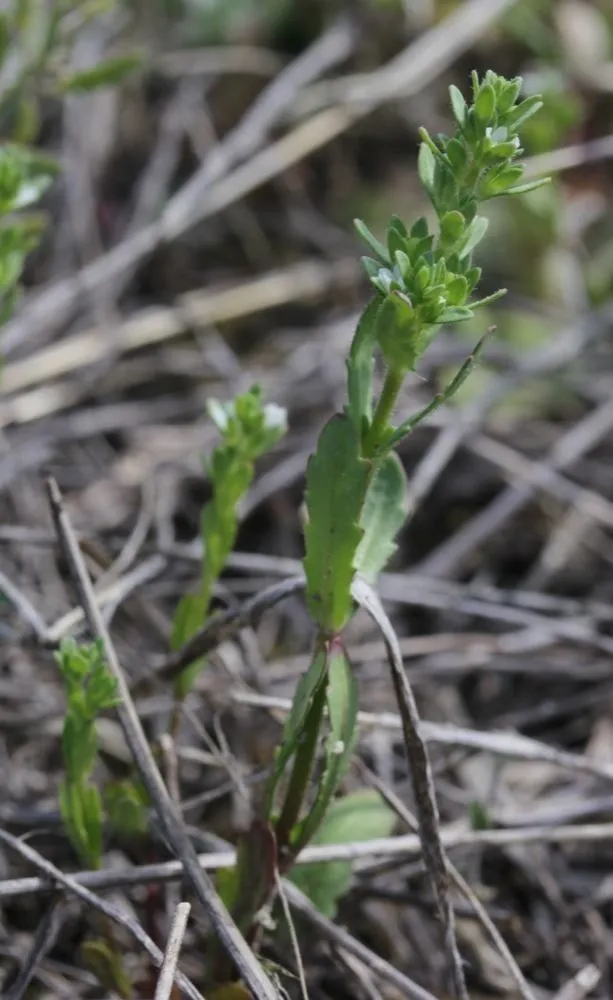
Author: L.
Bibliography: Sp. Pl.: 14 (1753)
Year: 1753
Status: accepted
Rank: species
Genus: Veronica
Vegetable: False
Observations: New World
Necklaceweed (Veronica peregrina), first documented in 1753, is a flowering plant belonging to the Plantaginaceae family. This interesting and versatile species is native to the New World, where it thrives in a variety of environments.
Despite its modest appearance, Necklaceweed has garnered attention for its hardiness and ability to adapt, making it a common sight in many areas across its native range. It is an annual herb, often found in moist, disturbed sites such as riverbanks, roadsides, and agricultural fields, indicating its preference for disturbed soils and its resilience in varying conditions.
Veronica peregrina features a slender, erect growth habit with smooth stems that can reach a height of 10 to 50 centimeters. The leaves are lanceolate to spatulate in shape and attach directly to the stem. The small flowers, usually white or pale blue, are arranged in spike-like racemes. These flowers, while not particularly showy, contribute to the plant’s straightforward and no-nonsense blooming style.
Its widespread presence and ability to grow in diverse habitats indicate Veronica peregrina’s crucial ecological role. It adds to the biodiversity of its environment, providing habitat and food for various insects. Furthermore, its adaptability makes it an excellent model for studying plant resilience and survival mechanisms in changing environments.
Necklaceweed’s significance extends beyond its ecological contributions. Its simple yet effective life cycle and relative ease of identification make it a familiar and accessible plant for botanists and naturalists alike, contributing to a broader understanding of plant distribution and evolution in the New World.
In summary, Veronica peregrina, or Necklaceweed, is a noteworthy member of the Plantaginaceae family, valued for its resilience and ecological contributions. Though it may appear humble, its ability to thrive in different environments underscores its importance in the plant kingdom.
Eng: american speedwell, necklace weed, necklaceweed, neckweed, purslane speedwell, wandering speedwell
Dan: amerikansk ærenpris
Deu: drüsen-fremd-ehrenpreis, fremder ehrenpreis, gewöhnlicher fremd-ehrenpreis
Pol: przetacznik obcy
Lit: svetimoji veronika
Ita: veronica pellegrina
Nld: vreemde ereprijs
Fra: véronique voyageuse, véronique étrangère, véronique pérégrine
Swe: muukalaistädyke, pilgrimsveronika
Fin: muukalaistädyke
Ces: rozrazil cizí, veronika cudzia
Nno: vandreveronika
Nob: vandreveronika
Por: verónica
Hun: vándorveronika
Est: võõrmailane
Cym: rhwyddlwyn america, rhwyddlwyn tramor, rhwyddlwyni america
En: Necklaceweed, Neckweed, Wandering speedwell, Purslane speedwell, American speedwell, Necklace weed
Zh: Wen mu cao, 毛蟲婆婆納
Cs: Rozrazil cizí, Veronika cudzia
Da: Amerikansk ærenpris
Nl: Vreemde ereprijs
Et: Võõrmailane
Fi: Muukalaistädyke
Fr: Véronique étrangère, Véronique voyageuse, Véronique pérégrine
De: Fremder Ehrenpreis, Drüsen-Fremd-Ehrenpreis, Gewöhnlicher Fremd-Ehrenpreis, Amerikanischer Ehrenpreis
Hu: Vándorveronika
It: Veronica pellegrina
Ja: Mushikusa
Ko: 문모초
Lt: Svetimoji veronika
Nb: Vandreveronika
Nn: Vandreveronika
Pl: Przetacznik obcy
Pt: Verónica
Ru: Вероника иноземная
Es: Veronica peregrina
Sv: Pilgrimsveronika, Muukalaistädyke
Zh-tw: 毛蟲婆婆納
Uk: Вероніка іноземна
Cy: Rhwyddlwyn America, Rhwyddlwyn Tramor, Rhwyddlwyni America
Taken May 13, 2020 by Kendra RaiderNature (cc-by-sa)
Taken Aug 27, 2022 by Gonçalves da Cunha Lucas (cc-by-sa)
Taken Sep 2, 2018 by Lisa J (cc-by-sa)
Taken May 25, 2021 by lopezlacasa (cc-by-sa)
Taken Aug 27, 2022 by Gonçalves da Cunha Lucas (cc-by-sa)
Taken May 17, 2020 by taylor jessicaaa (cc-by-sa)
Taken Oct 26, 2021 by Ortiz Carlos (cc-by-sa)
Taken Aug 6, 2021 by Rhonda Horton (cc-by-sa)
Taken Jun 28, 2022 by Leo S. (cc-by-sa)
Taken Jun 6, 2022 by Dennis Stewart (cc-by-sa)
© copyright of the Board of Trustees of the Royal Botanic Gardens, Kew.
© copyright of the Board of Trustees of the Royal Botanic Gardens, Kew.
© copyright of the Board of Trustees of the Royal Botanic Gardens, Kew.
Taken May 13, 2017 by Tela Botanica − Marie PORTAS (cc-by-sa)
Taken May 1, 2015 by EOL − Lena Struwe (cc-by-nc)
Taken Mar 9, 2016 by EOL − Nathan Taylor (cc-by-nc)
Taken Aug 27, 2022 by Gonçalves da Cunha Lucas (cc-by-sa)
Taken Oct 26, 2021 by Ortiz Carlos (cc-by-sa)
Taken Mar 9, 2016 by EOL − Nathan Taylor (cc-by-nc)
Taken Dec 6, 2015 by EOL − Bob O’Kennon (cc-by-nc)
Taken Mar 20, 2016 by EOL − Sam Kieschnick (cc-by-nc)
Taken Feb 26, 2016 by EOL − Sam Kieschnick (cc-by-nc)
Taken Feb 28, 2016 by EOL − Carolyn Gritzmaker (cc-by-nc)
Taken Jan 1, 1900 by EOL − Gerrit Davidse (cc-by-nc-sa)
Taken Jan 1, 1900 by EOL − Gerrit Davidse (cc-by-nc-sa)
Taken Jan 1, 1900 by EOL − Gerrit Davidse (cc-by-nc-sa)
Taken Apr 1, 2016 by EOL − Chuck Sexton (cc-by-nc)
Taken Mar 20, 2016 by EOL − Sam Kieschnick (cc-by-nc)
Taken May 15, 2004 by Photoflora – Benoit BOCK (©)
Taken May 15, 2004 by Photoflora – Benoit BOCK (©)
Taken Jan 1, 1970 by Photoflora – L’Abbé COSTE (©)
Taken Sep 15, 2009 by Photoflora – Benoit BOCK (©)
Taken May 14, 2010 by Tela Botanica − Bertrand BUI (cc-by-sa)
Growth habit: Forb/herb
Ph maximum: 7.5
Ph minimum: 7.0
Light: 8
Atmospheric humidity: 7
Soil nutriments: 8
Family: Myrtaceae Author: (F.Muell.) K.D.Hill & L.A.S.Johnson Bibliography: Telopea 6: 402 (1995) Year: 1995 Status:…
Family: Rubiaceae Author: Pierre ex A.Froehner Bibliography: Notizbl. Bot. Gart. Berlin-Dahlem 1: 237 (1897) Year:…
Family: Sapindaceae Author: Koidz. Bibliography: J. Coll. Sci. Imp. Univ. Tokyo 32(1): 38 (1911) Year:…
Family: Asteraceae Author: A.Gray Bibliography: Pacif. Railr. Rep.: 107 (1857) Year: 1857 Status: accepted Rank:…
Family: Fabaceae Author: Medik. Bibliography: Vorles. Churpfälz. Phys.-Ökon. Ges. 2: 398 (1787) Year: 1787 Status:…
Family: Aspleniaceae Author: (Cav.) Alston Bibliography: Bull. Misc. Inform. Kew 1932: 309 (1932) Year: 1932…